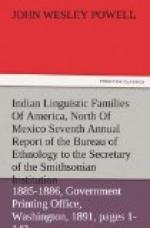Derivation: A corruption of the Algonkin word “nadowe-ssi-wag, “the snake-like ones,” “the enemies” (Trumbull).
Under the family Gallatin makes four subdivisions, viz, the Winnebagos, the Sioux proper and the Assiniboins, the Minnetare group, and the Osages and southern kindred tribes. Gallatin speaks of the distribution of the family as follows: The Winnebagoes have their principal seats on the Fox River of Lake Michigan and towards the heads of the Rock River of the Mississippi; of the Dahcotas proper, the Mendewahkantoan or “Gens du Lac” lived east of the Mississippi from Prairie du Chien north to Spirit Lake. The three others, Wahkpatoan, Wahkpakotoan and Sisitoans inhabit the country between the Mississippi and the St. Peters, and that on the southern tributaries of this river and on the headwaters of the Red River of Lake Winnipek. The three western tribes, the Yanktons, the Yanktoanans and the Tetons wander between the Mississippi and the Missouri, extending southerly to 43 deg. of north latitude and some distance west of the Missouri, between 43 deg. and 47 deg. of latitude. The “Shyennes” are included in the family but are marked as doubtfully belonging here.
Owing to the fact that “Sioux” is a word of reproach and means snake or enemy, the term has been discarded by many later writers as a family designation, and “Dakota,” which signifies friend or ally, has been employed in its stead. The two words are, however, by no means properly synonymous. The term “Sioux” was used by Gallatin in a comprehensive or family sense and was applied to all the tribes collectively known to him to speak kindred dialects of a widespread language. It is in this sense only, as applied to the linguistic family, that the term is here employed. The term “Dahcota” (Dakota) was correctly applied by Gallatin to the Dakota tribes proper as distinguished from the other members of the linguistic family who are not Dakotas in a tribal sense. The use of the term with this signification should be perpetuated.
It is only recently that a definite decision has been reached respecting the relationship of the Catawba and Woccon, the latter an extinct tribe known to have been linguistically related to the Catawba. Gallatin thought that he was able to discern some affinities of the Catawban language with “Muskhogee and even with Choctaw,” though these were not sufficient to induce him to class them together. Mr. Gatschet was the first to call attention to the presence in the Catawba language of a considerable number of words having a Siouan affinity.
Recently Mr. Dorsey has made a critical examination of all the Catawba linguistic material available, which has been materially increased by the labors of Mr. Gatschet, and the result seems to justify its inclusion as one of the dialects of the widespread Siouan family.
GEOGRAPHIC DISTRIBUTION.
The pristine territory of this family was mainly in one body, the only exceptions being the habitats of the Biloxi, the Tutelo, the Catawba and Woccon.




